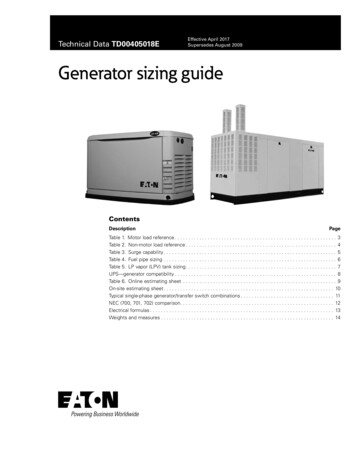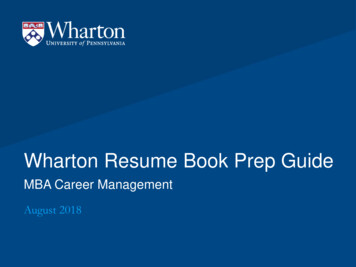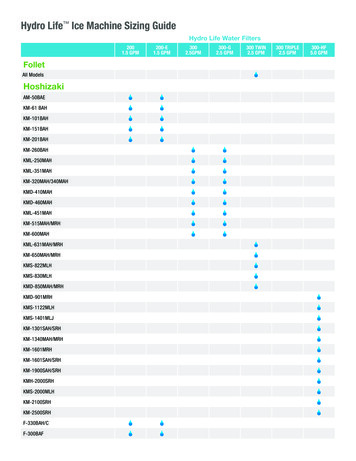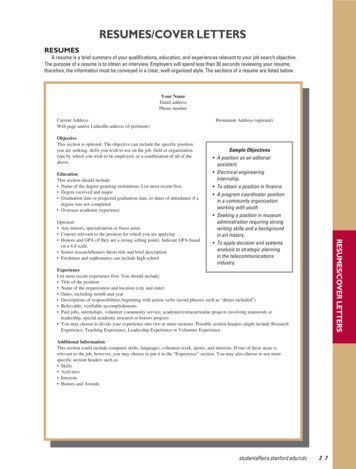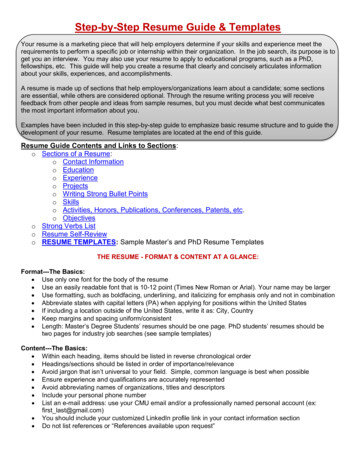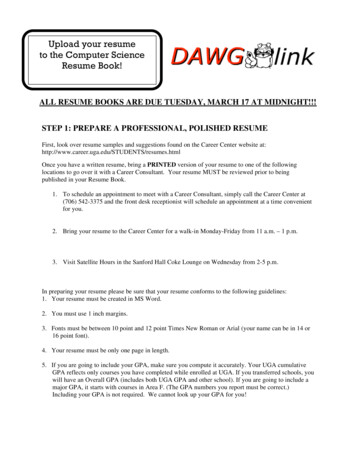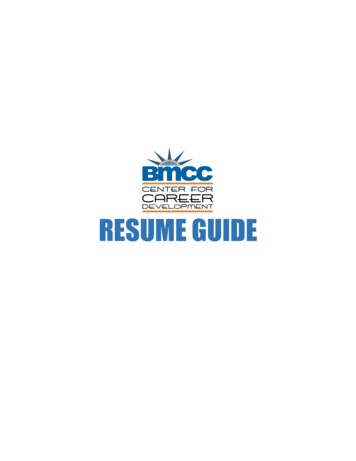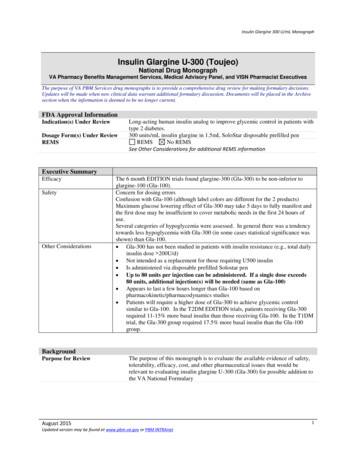
Transcription
DOCUMENT RESUMEED 300 240TITLEINSTITUTIONREPORT NOPUB DATENOTEAVAILABLE FROMPUB TYPEEDRS PRICEDESCRIPTORSIDENTIFIERSSE 049 755Biological Science: An Ecological Approach. BSCSGreen Version. Student Study Guide. A Resource Bookof Learning Skills Activities. Teacher's Edition.Sixth Edition.Biological Sciences Curriculum Study, ColoradoSprings.ISBN-0-8403-4447-387149p.; For Teacher's Edition, see SE 049 756;Teacher's Resource Book, see SE 049 757. Drawings maynot reproduce well.Kendall/Hunt Publishing Company, 2640 Kerper Blvd.,Dubuque, IA 52001 ( 5.90).Guides - Classroom Use - Materials (For Learner)(051) -- Guides - Classroom Use - Guides (ForTeachers) (052)MFO1 Plus Postage. PC Not Available from EDRS.*Biological Sciences; Course Organization; CriticalThinking; *Instructional Materials; Problem Solving;Science Activities; Science Education; SecondaryEducation; *Secondary School Science; *Study Guides;*Study Skills; Teaching Methods; *Textbooks*Biological Sciences Curr Study Green VersionABSTRACTThis study guide is designed to help students learnto use science skills to solve biological problems, learn to applyknowledge about biology in their own lives, and learn to communicatewith others about biology. The activities in this guide useinformation related to each chapter in the 1987 BSCS Green Versiontextbook. Students can use the activities before, during, or aftertheir study of the chapter. There are 99 activities and exercisesrelated to the 25 chapters of the textbook. These paper-and-pencilactivities direct students to make observations, collect data fromresearch sources, draw models and diagrams, and interpret and drawgraphs. This teacher's edition provides possible student responses.(CW)Reproductions supplied by EDRS are the best that can be madefrom the original document.*******a******* *********** *** ****** * ****** *** ***** ****** ********* ******
DOCUMENT RESUMEED 300 240TITLEINSTITUTIONREPORT NOPUB DATENOTEAVAILABLE FROMPUB TYPEEDRS PRICEDESCRIPTORSIDENTIFIERSSE 049 755Biological Science: An Ecological Approach. BSCSGreen Version. Student Study Guide. A Resource Bookof Learning Skills Activities. Teacher's Edition.Sixth Edition.Biological Sciences Curriculum Study, ColoradoSprings.ISBN-0-8403-4447-387149p.; For Teacher's Edition, see SE 049 756;Teacher's Resource Book, see SE 049 757. Drawings maynot reproduce well.Kendall/Hunt Publishing Company, 2640 Kerper Blvd.,Dubuque1 IA 52001 ( 5.90).Guides - Classroom Use - Materials (For Learner)Guides - Classroom Use - Guides (For(051)Teachers) (052)MF01 Plus Postage. PC Not Available from EDRS.*Biological Sciences; Course Organization; CriticalThinking; *Instructional Materials; Problem Solving;Science Activities; Science Education; SecondaryEducation; *Secondary School Science; *Study Guides;*Study Skills; Teaching Methods; *Textbooks*Biological Sciences Curr Study Green VersionABSTRACTThis study guide is designed to help students learnto use science skills to solve biological problems, learn to applyknowledge about biology in their own lives, and learn to communicatewith others about biology. The activities in this guide useinformation related to each chapter in the 1987 BSCS Green Versiontextbook. Students can use the activities before, during, or aftertheir study of the chapter. There are 99 activities and exercisesrelated to the 25 chapters of the textbook. These paper-and-pencilactivities direct students to make observations, collect data fromresearch sources, draw models and diagrams, and interpret and drawgraphs. This teacher's edition provides possible student ***********************************Reproductions supplied by EDRS are the best that can be madefrom the original ******************************
Student Study GuideBiological ScienceAn Ecological ApproachSixth EditionA Resource Bookof Learning Skills ActivitiesBSCS Green VersionBSCSThe Colorado CollegeColorado Springs, CO 80903Jean P. Milani, BSCS, Green Version Revision CoordinatorCaro! Leth Stone, Science Writer, Alameda, California, Principal AuthorEdward Drexler, Pius XI High School, MilwaukeeRichard R. Tolman, Brigham Young University, Provo, UtahTeacher's Editiontil(gn.dall/IfuntPublishing CompanyDubuque, Iowai
BSCS Production StaffDouglas J. RobertKatherine A. WinternitzArtistCarl J. BandyBSCS Administrative StaffJane Butler Kahle. Chair. Board of DirectorsJoseph D. Mcinerney, DirectorCopyright @ 1987 by BSCSISBN 0-8403-4447-3All rights reserved. No part of this publication may be reproduced,stored in a retrieval system, or transmitted, in any form or by anymeans, electronic, mechanical, photocopying, recording, or otherwise,without the prior written permission of the copyright owner.Printed in the United States of America109876543214
ContentsTo the Student viiiPreface to the TeacherviiiIntroductory Activity: Predicting Your FuturePart I1(Combined skill: Predicting)1.1 Getting Ready to Read 3(Combined skill: Reviewing background information)1.2 Taking Helpful Notes 4(Communication skill: Notetaking)1.3 Seeing with a Purpose 6(Science skill: Observing)1.4 Disappearing Marshlands 8(Combined skill: Generalizing a concept from the chapter to new instances)2.1 Writing about Populations 11(Communication skill: Freewriting)2.2 Pig Populations 12(Science skill: Describing properties and changes)2.3 Planning to Study Biology 15(Combined skill: Planning how to study)2.4 Population Profiles 16(Science skill: Inferring from data)3.1 Getting an Overview 17(Communication skill: Skimming before reading)3.2 A Shell Game19(Science skill: Observing)3.3 A Problem of Immunity 21(Science skill: Inferring)3.4 Finding a Niche 22(Combined skill: Generalizing a concept from the chapter to new instances)4.1 Writing an Outline 25(Communication skill: Outline writing)4.2 The Language of Science 26(Combined skill: Vocabulary)4.3 Using Tables of Data 28(Science skill: Using data tables)4.4 Variables 30(Science skill: Identifying variables)5iii
ivContents5.1 The Main Idea 33(Communication skills: Finding the main idea in a paragraph and Identifying the methodof paragraph development)5.2 Identifying a Hypothesis 34(Science skill: Identifying a hypothesis)5.3 Learning by Questioning 35(Combined skill: Writing questions and answers about written material)5.4 Diffusion 36(Combined skill: Generalizing a concept from the chapter to new instances)6.1 Library Research 39(Communication skill: Using the library)6.2 Picturing Meiosis 41(Science skill: Describing properties and changes)6.3 The Drosophila Life Cycle 42(Combined skill: Generalizing a concept from the chapter to new instances)6.4 Pangenesis 43(Science skill: Making predictions from hypotheses)7.1 Embyronic Development 45(Science skill: Observing and describing properties and changes)7.2 Understanding Embryonic Development 47(Communication skill: SQ3R method)7.3 Development of a Hypothesis 48(Science skill: Formulating hypotheses)7.4 Second-Hand Cigarette Smoke 50(Combined skill: Defending a thesis with evidence)8.1 Textbooks Aren't Perfect 51(Combined skill: Identifying fact v. opinion)8.2 The Lyon Hypothesis 52(Science skill: Interpreting data to test a hypothesis)(Combined skill: Generalizing a concept from the chapter to new instances)8.3 Editing a Paragraph 54(Communication skill: Editing a paragrapo9.1 Outlining the Theory of Evolution by Natural Selection(Communication skill: Outline some writing)9.2 Evolution Search 56(Combined skill: Using the library)559.3 Grouse: A Species Problem 56(Science skill: Revising a hypothesis)9.4 Finding Fallacies 59(Combined skill: Criticizing a statement)10.1 How Many Robins? 61(Science skill: Statistics)6
Contents10.2 Classification Bingo 62(Communications skill: Making and using self-review materials)10.3 Why We Have Oxygen 63(Science skill: Making a graph)10.4 Working as a Team 64(Communication skills: Giving instructions and Using teamwork)11.1 Skimming Paragraphs 65(Communication skills: Skimming for meaning and Learning the function of paragraphstructure)11.2 Identifying Bacteria 66(Science skill: Describing properties)11.3 Organizing Information 68(Science skill: Organizing data in graphs or tables)11.4 Rice69(Combined skill: Generalizing a concept from the chapter to new instances)12.1 Finding the Nucleus of an Idea 71(Communication skill: Finding the main idea in a paragraph)12.2 Writing a Short Bibliography 72(Combined skills: Using the library and Preparing a bibliography)123 Reading to Find Hypotheses 73(Science skill: Identifying a hypothesis)12.4 Whodunit? 74(Combined skill: Generalizing a concept from the chapter to new instances)13.1 Finding Information on Plants 75(Communication skill: Using the library)13.2 Reporting on Plants 75(Communication skill: Giving a class report)13.3 Tentative Explanations 76(Science skill: Formulating a hypothesis)13.4 Primitive Plants 77(Combined skill: Generalizing a concept from the chapter to new instances)14.1 Indoor Birdwatching 79(Science skill: Classifying)14.2 A Whale of a Tale 82(Communication skill: Editing a passage for clarity and correct usage)14.3 Seeing from All Sides 83(Combined skill: Visualizing in three dimensions)14.4 On Being Thick-Skinned 85(Science skill: Generalizing a concept from the chapter to new instances)15.1 Giving Instructions 87(Communication skills: Planning study, Skimming and Giving instructions)15.2 Animal Protein: How Essential? 88(Science skill: Refuting a hypothesis by testing)7v
viContents15.3 Mapping the Digestive Tract 89(Combined skill: Visualizing a concept in three dimensions)15.4 Some Medical Detective Work 90(Combined skill: Generalizing a concept from the chapter to new instances)16.1 Approaching Chapter 16 93(Communication skill: Using the SQ3R technique)16.2 Getting in Shape 94(Science skill: Using graphs and .ables16.3 Rew.ewing 95(Combined skill: Writing questions and answers about a chapter)16.4 Vitamin C 97(Combined skill: Generalizing a concept from the chapter to new instances)17.1 Skimming for Meaning 99(Communication skill: Skimming a passage)17.2 The Control of Blood Sugar Level 100(Science skill: Forming and using scientific models)17.3 A Pattern of Behavior 101(Combined skill: Generalizing a concept from the chapter to new instances)17.4 Cocaine 104(Combined skill: Generalizing a concept from the chapter to new instances)18.1 Yarrow Growth 105(Combined skill: Interpreting graphs and tables)18.2 Plant Growth 106(Communication skill: Finding topic sentences and rewriting for clarity)18.3 Sales Resistance 107(Combined skill: Refuting an argument using evidence and logic)18.4 Why Do Yarrow Plants Vary? 108(Combined skill: Generalizing a concept from the chapter to new instances)19.1 Identifying a Main Idea 111(Communication skill: Identifying a main idea in a paragraph)19.2 Effect of Gibberellic Acid 112(Science skill: Interpreting data in charts and graphs)19.3 Transplanting Photosynthesis 114(Combined skill: Generalizing a concept from the chapter to new instances)19.4 Mimicry Hypothesis 115(Science skill: Testing a hypothesis)20.1 Looking Ahead 117(Communication skill: Freewriting)20.2 A Fish Model 118(Science skill: Forming and using models)20.3 Finding Science Information 119(Combined skill: Using the library to plan and outline a science paper)
Contents21.1 Writ.1ig a Science Paper 123(Communication skill: Writing from an outline)21.2 Animal Families Through Time 124(Science skill: Using a data table)21.3 in Search of Early Artists 126(Science skill: Inferring)21.4 An Anthropology Song 127(Communication skill: Expanding science vocabulary)21.5 Surviving the Cold 128(Combined skill: Generalizing a concept from the chapter to new instances)22.1 Solar Radiation 131(Science skill: Interpreting or using graphs and maps)22.2 Reading About Biomes 133(Communication skill: SQ3R method)22.3 Biomes in 3 Dimensions 134(Combined skill: Visualizing in three dimensions)22.4 Where Biomes Meet 136(Combined skill: Generalizing a concept to a new example)23.1 A Muddy Sea Around Us 137(Communication skill: Editing a paragraph)23.2 Aquatic Variables 138(Science skill: Identifying variables)23.3 Chesapeake Bay 139(Combined skills: Generalizing a concept from the chapter to new instances andUnderstanding the social aspects)24.1 Cloudy Writing 141(Communication skill: Rewriting a passage)24.2 The Earliest Americans 142(Science skill: Inferring)24.3 Reconstructing Village Life 144(Combined skills: Generalizing a concept from a chapter to new :astances and Seeing itssocial aspect)25.1 Rewriting Your Rough Drafts 147(Communication skill: Rewriting a passage)25.2 Business and Recombinant DNA 147(Combined skills: Generalizing a concept from a chapter to new instances and Editing apassage)25.3 PredictionExtinction?149(Science skill: Making a prediction)Review Activity: Predicting Your FuturePart II151(Combined skill: Predicting)Concluding Activity: Arguing Your Ideas 153(Communication skill: Proposing and defending a thesis)9vii
To the StudentYour textbook presents the major ideas of biology, many specific facts, and a largenew vocabulary. At times, this information may seem overwhelming. However, youcan take charge of your learning and be successful in biology. This study guide willhelp you do so.The study guide will help you in three ways. First, it will help you learn to usescience skills to solve biological problems. By doing such things as hypothesizing,using data, and making inferences, you will understand why and how scientists usethose skills.Second, you will learn to apply your new knowledge about biology to the worldaround you. Memorizing the words or even the ideas of biology is useless unless youcan apply biology to your own life.4Third, you will learn to communicate with others about biology. You will learnhow to find out what others have written, and how to talk and write about biologyyourself.We hope the study guide will help you to master other learning, as well asbiology. We want to know if it helps you, and if you can suggest changes for the nextedition. Please send your comments to BSCS, the Colorado College, ColoradoSprings, Colorado 80903, Attn: GV6.Preface to the TeacherThe Student Study Guide is designed to enhance students' abilities in three specificareas: communication skills, science skills, and general cognition or combined skills.Activities use information related to each chapter to develop those skills. The typeof skill is identified at the beginning cf each activity.Students can use the activities before, during, or after their study of the chapter.The appropriate timing is indicated at the beginning of each activity.In many cases, space has been provided for student responses. In other cases,however, responses are best made in a binder, on scratch parr, or on index cards.Those situations are indicated in the student directions.Possible student responses may be suggested, but are not meant to be taken asthe only correct answers. Students should be encouraged to be creative and thoughtfulin responding to questions and problems presented in the guide.We hope you and your students will find the Student Study Guide a helpfullearnirl tool. We would appreciate any suggests you have concerning this guide.Please send them to BSCS, The Colorado College, Colorado Springs, Colorado80903, Attn: GV6.viiii
Introductory ActivityIntroductory ActivityCombined Skill: PredictingThis activity can be carried out during the first days of the school year.PREDICTING YOUR FUTUREMany of the things you will learn in biology are related to your own life and to your immediate surroundings. They also are related to what your life may be like in the future.What do you think your future will be? As a science fiction writer does, you can use your knowledgeof the present to make predictions. Be creative with your predictions, but make them realistic. Based onwhat you know and can guess, write your answers to the following questions. There are no right answersyet; you can check your work in twenty years.Twenty years from now, where in the world (or the solar system) do you think you will live?Will you live in a city or a rural area?Will you be married?How many children will you have?How will you care for your children?Will your parents live with you?11
2Introductory ActivityWhat sorts of foods will you eat? Where will they come from? Will you grow any of your own food?What sort of work will you do? Where will you do it?What sort of exercise will you get? Where will you go for it?How healthy do you expect to be?What will your surroundings be like? Crowded and polluted, or spacious and clean?Can you make any other predice3ns about your future?This activity is continued at the end of the guide, as "Review Activit)." Students are asked to reevaluatetheir predictions in light of v lyq they have learned during their year of biology.12
Chapter 1Activity 1.1Combined Skill: Rel,:ewing background information (or, in cognitive psychology terms, "activatingschemata")Students can use this activity before beginning the chapter.GETTING READY TO READIf you read a book written for a young child, you can finish it quickly. No words or ideas will seem strangeto you. Reading a book written for high school students is more difficult. Perhaps the authors use somewords you do not understand r refer to ideas you have forgotten since you first learned them. If youtry to read the book without enough background information, you will waste time, and you may misunderstand what you are reading.Your teacher may spend some class time reviewing words or ideas that will help the entire class.However, it is up to you to make sure that you are ready to read the chapter and understand it.To get ready, skim the chapter. Do the authors refer to some things without explaining them, assuming you already understand them? For example, do you know the meanings of the words "venture"and "microorganism"? Do you know how to use a stereomicroscope? In the space below, list a few thingsyou probably need to look up or learn before reading chapter 1 thoroughly:You will, of course, try to fill in any obk ious gaps in your students' backgrounds. Howeker, one of tilt.purposes of this guide is to make students monitor their own learning and take responsibility for findingout what they need to know.133
4Chapter 1Activity 1.2Communication Skill: NotetakingStudents can use this activity before or during the chapter.TAKING HELPFUL NOTESWhat you learn in biology class will come from several sou ces, such as laboratory work, the textbook,and your outside reading. One important source of information is your teacher. This activity will helpyou to write down information your teacher gives you and to use it later.The following example is taken from one biology student's class notes. Notice what the student didwhile taking the notesunderlining, sketching something the teacher drew on the chalkboard, and soon.ad/crial C/fozezi4/a2x2J5f.-e.2ayi2 72 o ze ,fre,cryrie)/i7-7a/Ao- )-.Jobi6-- avrei)wial92a.a4, -- /lay.dia&AraZpeaea)4(1,111101,.r&-Irierle49etaeeP .77ehe algh-44 700a/erya1) - dea2yealas?'4:14/lat7/5-/14
Chapter 15Why do you think the student added stars to some terms?The teacher probably emphasized them or said they would reappear on tests.After class, the student and some friends looked over their notes together. They helped each otherunderstand the material. They looked up some words in the textbook and a dictionary. After that, thestudent typed the notes and put them in a permanent biology notebook. (The notes about the quiz andthe play tryouts went into a little reminder book.) The typed notes looked like this:Oct. 1Food chains and webs*Interrelationships-ways organisms affect each other. Includes eatingand other relationships.*Food chain--series of steps in the passage of food from one organism toanother. Always includes one plant; may include one animal or several, aswell as decomposers.*Decomposer--anything that decomposes (rots) tissue, such as bacteria ormold.General food chain:plant animal animal decomposerExamples:grass rabbit coyote maggotsgrass ewe lamb coyote(Arrow eaten by, or gives milk or other food to)*Food web--two or more food chains with some shared organisms, such as:grass rabbit coyote maggots\- ewe lambJ115
6Chapter 1Reviewing and copying your notes may seem like a lot of work. But most students who do it find thatthey save time later in studying for tests. Try it on your notes from the next biology class.No space is prcvided here for response by the student, it is hoped that he or she already has a spiralbound notebook for taking notes in class. Encourage students to type and hand in a copy of their notesfrom at least one class period; if possible, hav c them continue the practice throughout the year and savetheir notes in a permanent notebook. Help them also by emphasizing that cooperating in reviewing andcopying notes is not "cheating" unless someone uses it as a substitute for class attendance.Activity 1.3Science Skill: ObservingStudents can carry out this activity before or dur:ng the chapter.SEEING WITH A PURPOSEWhen you have some understanding of how living things grow and behave, you can more easily or:entyourself in your surroundings. This was very useful to the Native Americans, who had no compasses. Inthe words of an 18th-century French priest, Pere Lafitau, who spent five years with the Iroquois tribe,the Iroquois "pay great heed to their 'star' compass [the Pole Star] in the woods and in the vast prairies. . . . But when the sun or stars are not visible they have a natural compass in the trees of the forestfrom which they know the north by almost infallible signs."The first is that of their tips, which always lean toward the South, to which they are attracted bythe sun. The second is that of their bark, which is more dull and dark on the north side [where there isless evaporation, and the moist bark looks darker]. If they wish to be sure they only have to give the treea few cuts with their axe; the various tree rings which are formed in the trunk of the tree are thicker onthe north side." (From Harold Gatty, 1958, Nature is Your Guide (New York: Penguin Books).)16
8Chapter 1These methods are not always reliable. What might cause a tree to grow toward the north, or to be moisteron the south side?Shade may be cast by buildings or by natural surroundings. Wind direction also affects growth.Activity 1.4Combined Skill: Generalizing a concept from the chapter to new instancesStudents can use this activity after completing chapter 1.DISAPPEARING MARSHLANDSSan Francisco Bay was surrounded by marshes when the Spanish explorer Gaspar de Porto lo arrived in1769. He found the Oh lone Indians hunting deer, rabbits, and other game in the tall marsh grasses.In the .:ears since, many of the marshes have been drained for various human purposes. Many persons see the marshes as wet, smelly places that hurt property values. However, many animals and plantscan live only there, and many others depend on organisms that live there.About three dozen kinds of birds live there year-round. These include ducks, grebes, coots, killdeer,avocets, stilts, and clapper rails. They feed on small animals that live in the mudworms, snails, andshellfish (clams, mussels, oysters, and shrimp). Those small animals in turn eat very small marsh producers such as diatoms and algae. They also eat detritus (decaying plant and animal matter).Much detritus comes from plants that can tolerate high concentrations of salt, such as cordgrass,salt grass, marsh rosemary, alkali heath, picklewood, and Australian saltbush. (In addition to providingmaterial as detritus, the pickleweed performs the role of host to a parasitic plant called salt marsh dodder,and the leaves of the Australian saltbush are the food of the caterpillars of pygmy blue butterflies, thesmallest butterflies in North America.)Land birds such as sparrows, meadowlarks, and blackbirds may come to the marsh to feed on insects, and they may become food for larger birds such as kites, short-eared owls, and marsh hawks.In the mud along the water's edge, crabs and shrimp provide food for migratory birds: among them,sandpipers, ducks of many kinds, great blue herons, and great egrets. These last two also feed on mice.One kind of mouse, the red-bellied salt marsh harvest mouse, is an endangered species. It livesnowhere else. It is fed on by hawks, owls, herons, and gulls.Humans fish for striped bass, surfperch, Pacific herring, sturgeon, and flounder in the bay. We alsouse its shellfish. Fish feed on plants, snails, and small shellfish.In the space provided on the following page, draw a food web based on the information above.18
Chapter 1votvN.a,ri.SOA pper cats'N \-savo ce.-VsSCEa.e-e-c-Coo-!rhN-sr. he.oVsVnoci-eac-e.d.otzksicik esSpacro Lostmeacw\,ualsic-6T-ebe.ssand cice rs(Yei*tr.e.ok6' )e-VerMvesc-e.isfnmiui or r.nbokerW.sr-a. IsSt" e.AISVN/\\A v,Sk-raki av\ sa,\\ pus\-\a;a:sconksc.oc-cs, y6ssScrassnNarSkr\ealVr-bxSaki macs'19VA.e9
10Chapter 1The marshes are now restricted to 51 square miles of open space. Many persons using the area wouldlike to drain some of the areas that remain, making them usable for such purposes as airport runways.Comment on the possible effects of such drainage.Species restricted to the marsh, notably the salt harvest mouse, would disappear. As the plants, detritus,and invertebrates disappeared, so would the larger shellfish and fish used by humans.
Chapter 2Activity 2.1Communication Skill: Freewriting.Students can do this before reading the chapter. It gives them an oprortunity to write about sciencewithout the distraction of worrying about whether their ideas are "correct;" in addition, you can use theirquestions as a basis of discussion.WRITING ABOUT POPULATIONSBefore beginning this activity, get out a pen'or pencil and several sheets of scratch paper. Then glancethrough chapter 2 in your textbook for a minute or two.Now, close the book. For five minutes, write down what you know about populations. You can include topics from the textbook and topics you may know about from other sources. Don't worry aboutspelling or grammar; just write freely, getting your ideas down on paper. Don't worry about whether yourideas are right, either.You probably have some questions about populations. Write those on a separate sheet of paper orunderline them, so they stand out from the rest of what you have written.When the time is up, go back and organize what you have written. Write at least three paragraphsto show your teacher. These should be corrected for grammar and spelling. Write your questions in thespace below. Your teacher may ask to see the questions now, or you may want to bring them up in classdiscussions.My questions about populations:2111
12Chapter 2Activty 2.2Science Skill: Describing properties and changesStudents can do this after reading the chapter.PIG POPULATIONSTwo groups of pigs were kept in adjacent pens. The fences around the pens were high and strong, butthe hedge separating the two groups of pigs was not strong enough. Sometimes pigs were able to getthrough the hedge.Area AArea BAt the beginning of Year I, all the pigs in Area A were of the Spct breed, which looked like this:IP-1-1SPOTFrom "Modern Pork Production" by Wilson G. Pona. Copyright 0 May 1983 by ScientificAmerican, Inc. All rights reserved.22
Chapter 2All the pigs in Area B were of the Yorkshire breed, which looked like this:--.)I.1\',fIsmYORKSHIREFrom "Modern Pork Production" by Wilson G. Pond. Copyright May 1983 by ScientificAmerican. Inc. All rights reserved.Events during Year 1 are shown in the following table:Area AYear 1 starting population sizeNumber of birthsNumber of deathsNumber of emigrationsNumber of immigrationsArea B69182169911119At the end of Year 1, how many pigs were in each area?Area AArea B99Yorkshire1110Total2019SpotEvents during Year 2 are shown in the following table:Year 2 starting population sizeNumber of birthsNumber of deathsNumber of emigrationsNumber of immigrations.Area AArea B205520252719'. .471927252313
14Chapter 2At the beginning of Year 3, none of the pigs looked like those shown above. Mclike these pigs:f them looked morec.1\1/i-v bIsvrEvents during Year 3 arc shown in the following table:Year 3 starting population sizeNumber of birthsNumber of deathsNumber of emigrationsNumber of immigrationsArea AArea B574528570100225605050100How many pigs were in Area A at the end of Year 3?In ,. --A B?222260What rate was primarily responsible for the changes in both population sizes during Year 3?NatalityTry to account for this.Students should observe that the pigs appear different artj calculate that the birth rate has about doubled.Though they may not be familiar with the "hybrid vigor" that is responsible, they should relate theincreased birth rate to the changes in the pigs.24
Chapter 215Activity 2.3Combined Skill: Planning how to studyStudents can do this while reading the chapter.PLANNING TO STUDY BIOLOGYBy now, you have some idea of what to expect from your biology course. How can you take charge ofyour work, so that you will learn as much as you can?It goes without saying that you need to know what the assignments are and when they are due.Your teacher will tell you about the reading assignments and the tests, as well as any other work that isexpected of you. From that point, it is up to you.One thing that will help you is planning ahead. You need to estimate the time needed for readingthe assignments, doing problems, studying for tests, and so on. Based on what has happened so far thisyear, fill out this tentative weekly schedule:ActivityAmount of timeDay and timeReading biology assignmentsReviewing biologyassignmentsStudying for biology testsOther (extra projects, etc.)The amount
TITLE Biological Science: An Ecological Approach. BSCS. Green Version. Student Study Guide. A Resource Book of Learning Skills Activities. Teacher's Edition. Sixth Edition. INSTITUTION Biological Sciences Curriculum Study, Colorado. Springs. REPORT NO ISBN-0-8403-4447-3 PUB DAT


